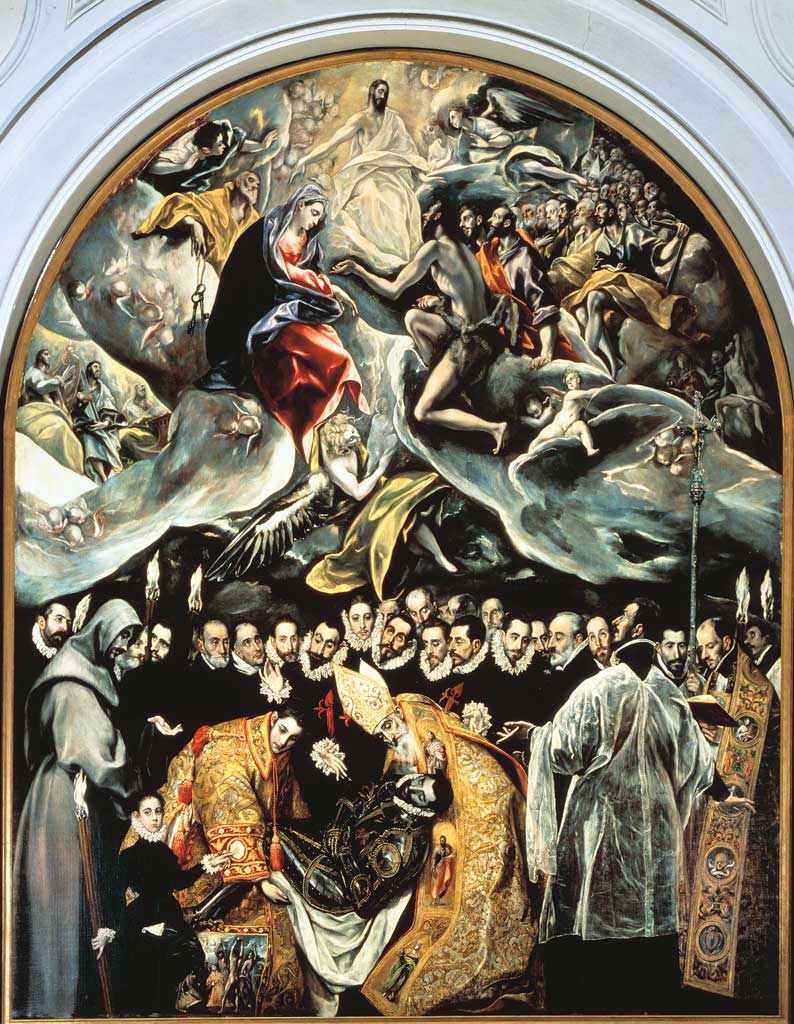Great Works: The Burial of the Count of Orgaz, 1586-88 (480cm x 360cm), El Greco
Parish Church of Santo Tomé, Toledo

Your support helps us to tell the story
From reproductive rights to climate change to Big Tech, The Independent is on the ground when the story is developing. Whether it's investigating the financials of Elon Musk's pro-Trump PAC or producing our latest documentary, 'The A Word', which shines a light on the American women fighting for reproductive rights, we know how important it is to parse out the facts from the messaging.
At such a critical moment in US history, we need reporters on the ground. Your donation allows us to keep sending journalists to speak to both sides of the story.
The Independent is trusted by Americans across the entire political spectrum. And unlike many other quality news outlets, we choose not to lock Americans out of our reporting and analysis with paywalls. We believe quality journalism should be available to everyone, paid for by those who can afford it.
Your support makes all the difference.You see it as you enter the chapel of the Parish Church of Santo Tomé in Toledo, directly above the tomb of the Count of Orgaz. There are many paintings by El Greco in the nearby Cathedral of Toledo, but none that quite matches this one in size, drama or intensity. The painter had nine months in which to do it, and the instructions were quite specific. To dramatically engulf the space, that was the instruction. Nothing was to be left unpainted between the top and the bottom of the arch. And, most important of all, he was to include a depiction of the miracle that had supposedly happened on that extraordinary day in 1323, about 260 years before he put brush to canvas.
As the body of the deceased Count of Orgaz was being laid in its tomb with all due ceremony, Saint Augustine and Saint Stephen appeared, in person, to relieve the local priests of the need to do the heavy lifting. The saints, one elderly and bearded, and the other touchingly young (the very flesh of his right cheek seems to blush with youthfulness), and both wonderfully vestmented, are taking bodily charge of this man with the lolling head, so trimly bearded even in death, tricked out in his gleaming suit of armour, as we arrive at the scene as astonished spectators.
Even today we cannot but rear back a little at the sight of this painting. It is so shockingly crowded and tumultuous, and yet all is so beautifully defined within so densely populated a space. One space, did I hear you say? Surely there is not one but two spaces here, imaginatively speaking at least. There is the solemn, funereal space of the here-and-now, which occupies the lower half of the canvas, and then there is the near-chaotic, hosanna-charged upper region, the heavenly environment, much more swirlingly ethereal, where beings of quite a different look and deportment hold sway. And what is so interesting is that El Greco paints these two kinds of beings, the earthly and the heavenly, in distinctively different ways. The heavenly beings, with their extraordinary elongations and stiff, hieratic poses, wing us back in memory to the work of the young El Greco, the man who was trained as a painter of icons.
The humans in the lower half of the painting, on the other hand, are flesh and blood creatures, each one crisply personalised and soberly, sombrely, realistically rendered, with their pointed beards and their gorgeous ruffs, and the way they seem to be mingling together, cheek by jowl, as if they were all known to each other – yes, there have been many attempt by scholars to put names to these faces.
Is the lower half of the painting, that earthly realm of second-movement-of-the-Eroica solemnity, aware of what is happening up above? Can it see that the virgin is about to receive the soul of the count into heaven, and that massed crowds of saints, angels, prophets and such like, are waiting there in rhapsodic expectation? Look at that good half-theatre-full of tiered spectators on the right, for example.
The priest who has perhaps been relieved of the heavy lifting appears to know. While gesturing towards the body of the count with his left hand, he also has his eyes raised up. And there are other kinds of interconnectedess, too. See how that priest's diaphanous vestments connect us with the general diaphanousness of the upper realm.
We spend a lot of time half-seeing through cloth that billows and swings like clouds. And then there is this sensational use of yellow – how rich-egg-yolk thick and bright it looks! – whether below, as it appears to bear down across the back of Saint Stephen, or above, where it gives an extraordinary touch of visual glamour to an otherwise beatifically distracted St Peter, the old man who sits comfortably ensconced in the air behind the Virgin, with the keys to paradise idly depending from his long and rather disengaged fingers.
Join our commenting forum
Join thought-provoking conversations, follow other Independent readers and see their replies
Comments